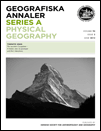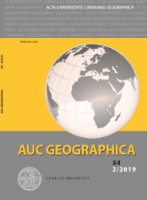
GEOGRAFISKA ANNALER SERIES A-PHYSICAL GEOGRAPHY
Scope & Guideline
Charting New Paths in Earth and Planetary Sciences
Introduction
Aims and Scopes
- Physical Geography and Earth Surface Processes:
Research contributions that explore the dynamics of the Earth's surface, including landforms, hydrology, and climate interactions. - Climate Change and Environmental Impact Studies:
Papers assessing the effects of climate change on various geographic and environmental phenomena, including glacier dynamics and hydrological changes. - Geomorphology and Landscape Evolution:
Focus on the processes shaping landforms and landscapes, including studies on glacial, periglacial, and fluvial environments. - Remote Sensing and Geospatial Analysis:
Utilization of advanced methodologies like remote sensing, GIS, and UAV technology to study and monitor environmental changes. - Paleoenvironmental Reconstruction:
Research that reconstructs past climates and environments through various dating techniques and sediment analysis, contributing to understanding long-term changes.
Trending and Emerging
- Glacier Dynamics and Climate Interactions:
An increasing number of studies focus on the interactions between glaciers and climate change, highlighting the importance of understanding glacier response and its implications for water resources. - Advanced Remote Sensing Techniques:
There is a growing trend in utilizing sophisticated remote sensing technologies and GIS methodologies for environmental monitoring and analysis, reflecting the journal's commitment to innovative research approaches. - Hydrological Studies and Water Resources Management:
Research on hydrology, particularly in relation to climate change impacts on water resources, has gained traction, emphasizing the importance of understanding water dynamics in changing environments. - Landslide and Hazard Assessment:
The rise in studies focusing on landslide susceptibility and hazard assessments indicates an increasing concern for natural disasters and their impacts on human activities and safety. - Paleoclimatology and Landscape Reconstruction:
Emerging interest in reconstructing historical climate and landscape changes using various dating techniques is evident, as researchers seek to understand long-term environmental shifts.
Declining or Waning
- Traditional Geomorphological Mapping:
While geomorphological mapping remains important, there has been a noticeable shift towards more quantitative and technological approaches, leading to a decrease in purely descriptive studies. - Human-Environment Interaction Studies:
Research focusing solely on human impacts on physical geography has seen a decline, as the journal increasingly emphasizes natural processes and climate effects. - Static Climate Studies:
Papers that examine climate conditions without considering dynamic interactions and changes over time are becoming less common, reflecting a move towards more integrated climate studies.
Similar Journals

Quaestiones Geographicae
Innovating Insights in Earth and Planetary SciencesQuaestiones Geographicae, an esteemed open-access journal published by SCIENDO, serves as a vital platform for scholarly communication in the field of Earth and Planetary Sciences. Since its inception in 1979, the journal has been dedicated to promoting rigorous research and discourse in geography, encompassing a breadth of topics that reflect the dynamic nature of the discipline. With an impressive Impact Factor belonging to the Q3 quartile category, the journal actively contributes to the global scientific community's understanding of geographical phenomena. Its commitment to open-access publishing since 2010 ensures that groundbreaking research is accessible to a wider audience, facilitating collaboration and innovation. As part of its enduring legacy, Quaestiones Geographicae engages researchers, professionals, and students alike, inviting them to explore, share, and expand the boundaries of geographical knowledge.

Physio-Geo
Connecting Disciplines, Transforming KnowledgePhysio-Geo (ISSN: 1958-573X) is a distinguished open-access journal published by REVUES ORG, dedicated to advancing the fields of Earth and Planetary Sciences, with a special focus on Earth-Surface Processes, Environmental Science, and Ecology. Since its inception in 2007, Physio-Geo has provided a platform for researchers, professionals, and students to disseminate and access high-quality studies that contribute to the understanding of our environment. With a convergence period from 2019 to 2024, the journal aims to bridge disciplinary gaps and foster interdisciplinary research that addresses pressing ecological and environmental challenges. Despite its current Scopus rankings reflecting an early-stage development, the journal is poised to enhance its impact within the scientific community, particularly as it embraces a wider audience through its open-access model. By offering valuable insights and comprehensive analyses, Physio-Geo is an essential resource for those seeking to explore the complex interactions between physical geography and ecological systems.

PHYSICAL GEOGRAPHY
Exploring the Dynamics of Earth and EnvironmentPHYSICAL GEOGRAPHY is a prominent academic journal published by Taylor & Francis Ltd, focusing on a wide array of topics within the realm of physical geography, including atmospheric science, earth sciences, and environmental science. With an esteemed history since its inception in 1975 and covering research up to 2024, this journal holds significant relevance in academia, evidenced by its ranking in the Q2 category for both Earth and Planetary Sciences and Environmental Science, as well as its Q3 standing in Atmospheric Science for 2023. This journal serves as a vital platform for scholars and practitioners alike, fostering the dissemination of innovative research findings and interdisciplinary collaboration. Although it is not an Open Access journal, it remains highly regarded, with Scopus rankings placing it within the top percentile of its categories. Researchers, professionals, and students seeking to contribute to or keep abreast of critical developments in the field will find PHYSICAL GEOGRAPHY an indispensable resource for advancing their knowledge and understanding of physical geographic phenomena.

Revista Brasileira de Geomorfologia
Advancing Knowledge in Geomorphological TransformationsRevista Brasileira de Geomorfologia is a prominent open-access journal dedicated to the field of geomorphology, fostered by the UNIAO GEOMORFOLOGIA BRASILEIRA since its inception in 2000. Based in Brazil, this journal serves as a vital platform for researchers, professionals, and students to disseminate and engage with cutting-edge research on the dynamic processes shaping the Earth's surface. With an ISSN of 1519-1540 and an E-ISSN of 2236-5664, it has earned its place within the academic community, ranking in the Q3 category in the Earth-Surface Processes domain according to the latest 2023 quartiles. The journal's metrics, including a Scopus rank of 123/179 within its category, reflect its commitment to quality research. By facilitating open access to its content, the Revista Brasileira de Geomorfologia not only promotes scholarly communication but also enhances the visibility of vital studies detrimental to understanding geomorphological transformations and environmental change. Join the ongoing discourse and contribute to advancing knowledge in this essential field of Earth sciences.

Frontiers of Earth Science
Connecting Researchers to the Frontiers of DiscoveryFrontiers of Earth Science is a prominent academic journal in the field of Earth and Planetary Sciences, published by Springer. With an ISSN of 2095-0195 and an E-ISSN of 2095-0209, this journal serves as a significant platform for researchers and professionals to disseminate their findings from 2007 to 2024. It is recognized for its impactful contributions within the category of Earth and Planetary Sciences, boasting a respected Q2 ranking in 2023. With a Scopus ranking of 64 out of 195, placing it in the 67th percentile, Frontiers of Earth Science continues to drive academic dialogue and innovation. The journal is dedicated to exploring a diverse range of topics, including geology, meteorology, and environmental science, and amplifying the understanding of Earth systems through rigorous research. Located in New York, USA, this journal embraces an Open Access model, ensuring that groundbreaking research is readily available to the global scientific community, thereby enhancing its accessibility and impact.

Journal of Asian Earth Sciences-X
Fostering Collaboration for Sustainable Earth SolutionsJournal of Asian Earth Sciences-X, a distinguished publication by ELSEVIER, is at the forefront of Earth and planetary sciences, particularly focusing on the dynamic fields of geology and earth-surface processes. As an Open Access journal since 2019, it provides unparalleled access to high-quality research, fostering global collaboration and dissemination of knowledge. With an impressive impact factor and ranking in the Q2 category for both Earth-Surface Processes and Geology, it serves as a crucial platform for researchers, professionals, and students alike to share their findings and insights. Situated in the United Kingdom, the journal thrives on contributions that enhance our understanding of Asian geosciences within a broader global context, aiming to tackle major challenges such as climate change and natural resource management. By bridging regional studies with global perspectives, the Journal of Asian Earth Sciences-X is not only a vital resource for academia but also supports sustainable development initiatives across the region.

Morphology
Pioneering Research in Morphological StudiesMorphology is a leading academic journal published by Springer, dedicated to the field of linguistics and language, with an impressive 2023 Category Quartile of Q1 reflecting its high impact and quality. Established in 2006, this international journal presents cutting-edge research and advancements in morphological studies, providing a vital platform for scholars and practitioners to disseminate their findings and insights. With its Scopus rank placing it in the top 10% of journals in the Arts and Humanities (Language and Linguistics), Morphology plays a pivotal role in shaping the discourse within the field. The journal maintains a commitment to excellence and rigor, catering to a wide readership that includes researchers, professionals, and graduate students eager to explore the complexities of language structure. Although currently not open access, Morphology ensures that its content is accessible through various institutional subscriptions, facilitating widespread engagement with important linguistic research.

AUC Geographica
Navigating the Complexities of Our PlanetWelcome to AUC Geographica, a distinguished journal published by CHARLES UNIV PRAGUE, KAROLINUM PRESS, focusing on the expansive and interdisciplinary fields of Earth and Planetary Sciences, as well as Geography, Planning, and Development. With an ISSN of 0300-5402 and an E-ISSN of 2336-1980, this Open Access journal has been freely accessible since 2010, allowing researchers, professionals, and students to engage with high-quality scholarly articles without barriers. As of 2023, it holds a Q4 ranking in its respective categories, reflecting its commitment to contributing to the academic discourse despite competitive landscapes. Located in Prague, Czech Republic, at OVOCNY TRH 3/5, PRAGUE 1 116 36, AUC Geographica aims to foster collaboration and innovative research in the multifaceted relationships between human activities and the natural environment. With a publication history spanning from 1975 to 2024, this journal continues to be a vital resource for those seeking to advance knowledge and explore new dimensions in geography and Earth sciences.

Earth Interactions
Advancing Knowledge of Planetary Interactions and DynamicsEarth Interactions is a prominent journal that serves as a critical platform for interdisciplinary research in the field of Earth and Planetary Sciences. Published by the American Meteorological Society, this journal has established itself as a key resource for scholars, researchers, and professionals dedicated to understanding Earth's complex systems and their interactions. With an impressive Q1 ranking in the category of Earth and Planetary Sciences for 2023, it reflects a commitment to high-quality scholarship and impactful contributions to the field. The journal, with its dedicated coverage from 2004 to 2024, encompasses a wide array of topics, providing comprehensive insights into geological, atmospheric, and environmental phenomena. Although it operates under a non-open access model, its significance is underscored by its placement in the top percentile of Scopus rankings (Rank #89/195), making it an exciting resource for those pursuing advanced studies and applications related to Earth's systems.

Remote Sensing
Empowering Science with Open Access to Remote Sensing DiscoveriesRemote Sensing is a highly esteemed journal published by MDPI, dedicated to the domain of Earth and Planetary Sciences. With an impressive impact factor reflected in its rank of #16 out of 195 in the general Earth and Planetary Sciences category, this journal achieves a commendable 92nd percentile among its peers, indicating its significant contribution to the field. Since its inception in 2009 as an Open Access journal, it has enabled researchers, professionals, and students from around the globe to access high-quality, peer-reviewed articles that delve into the latest advancements in remote sensing technologies, methodologies, and applications. Based in Switzerland, Remote Sensing serves as a vital platform for disseminating innovative research that supports and enhances our understanding of Earth's processes and environments, ensuring scientific knowledge remains freely accessible and impactful.